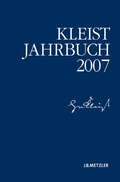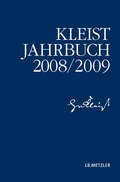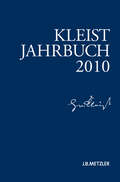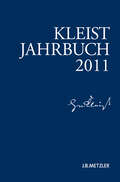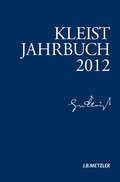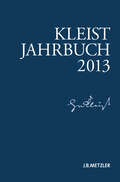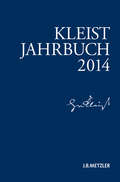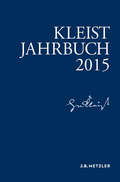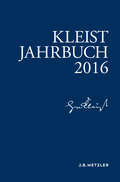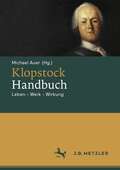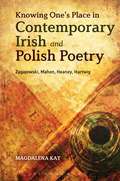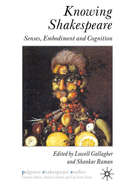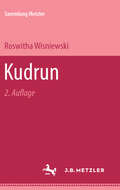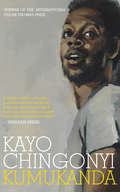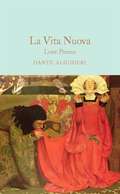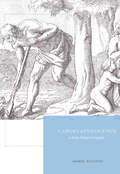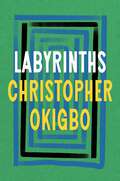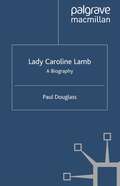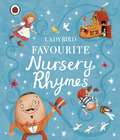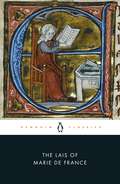- Table View
- List View
Kleist-Jahrbuch 2007
by Heinrich-von-Kleist-Gesellschaft Heinrich-von-Kleist-Gesellschaft und des Kleist-MuseumsZur aktuellen Kleist-Forschung. Die Dokumentation der Tagung "Kleist Choreographien 2006" und Rezensionen wissenschaftlicher Neuerscheinungen zu Kleists Leben, Werk und Wirkung geben einen Überblick über die jüngsten Ergebnisse. Mit einer Rede von Daniel Kehlmann, Kleist-Preisträger 2006.
Kleist-Jahrbuch 2008/09
by Heinrich-von-Kleist-Gesellschaft Heinrich-von-Kleist-Gesellschaft und des Kleist-MuseumsDas Jahrbuch dokumentiert die Verleihung des Kleist-Preises 2007 und 2008 u. a. mit den Reden der Preisträger Wilhelm Genazino (2007) bzw. Max Goldt (2008). Es beinhaltet die Beiträge der internationalen Tagung Kleists Affekte 2008 in Berlin sowie Abhandlungen zu Kleists Werken und Rezensionen wissenschaftlicher Neuerscheinungen zu Kleist.
Kleist-Jahrbuch 2010
by Heinrich-von-Kleist-Gesellschaft Heinrich-von-Kleist-Gesellschaft und des Kleist-MuseumsDas Jahrbuch dokumentiert die Verleihung des Kleist-Preises 2009 u. a. mit der Rede des Preisträgers Arnold Stadler. Es beinhaltet Beiträge zur Rezeptions- und Forschungsgeschichte sowie Abhandlungen zu Kleists Werken und Rezensionen wissenschaftlicher Neuerscheinungen zu Kleist.
Kleist-Jahrbuch 2011
by Heinrich-von-Kleist-Gesellschaft Heinrich-von-Kleist-Gesellschaft und des Kleist-MuseumsDas Jahrbuch dokumentiert die Gründung der Heinrich-von-Kleist-Gesellschaft im Jahr 1960, die Verleihung des Kleist-Preises 2010, die internationale Tagung Kleist/Politik 2010 in Berlin sowie die Eröffnung der Ausstellung Kleist: Krise und Experiment . Beiträge und Abhandlungen zu Kleists Werken und Rezensionen wissenschaftlicher Neuerscheinungen zu Kleist beschließen den Band.
Kleist-Jahrbuch 2012
by Heinrich-von-Kleist-Gesellschaft Heinrich-von-Kleist-Gesellschaft und des Kleist-MuseumsZur jüngsten Kleist-Forschung: Das Jahrbuch dokumentiert die Verleihung des Kleist-Preises 2011, u. a. mit der Rede der Preisträgerin Sibylle Lewitscharoff. Es beinhaltet die Beiträge der Tagungen "Adel und Autorschaft", "Ökonomie des Opfers" und "Vertrauen im Werk Heinrich von Kleists und in der Literatur um 1800". Abhandlungen zum Werk und Rezensionen zu wissenschaftlichen Neuerscheinungen beschließen den Band.
Kleist-Jahrbuch 2013
by Heinrich-von-Kleist-Gesellschaft Heinrich-von-Kleist-Gesellschaft und des Kleist-MuseumsZur jüngsten Kleist-Forschung: Das Jahrbuch dokumentiert die Verleihung des Kleist-Preises 2012, unter anderem mit der Rede des Preisträgers Navid Kermani. Es beinhaltet die Beiträge der Tagungen "Kleists Briefe" und des Nachwuchskolloquiums Natur im Werk Heinrich von Kleists . Abhandlungen zum Werk und Rezensionen wissenschaftlicher Neuerscheinungen beschließen den Band.
Kleist-Jahrbuch 2014
by Heinrich-von-Kleist-Gesellschaft Heinrich-von-Kleist-Gesellschaft und des Kleist-MuseumsDokumentation der Verleihung des Kleist-Preises 2013, unter anderem mit der Rede der Preisträgerin Katja Lange-Müller. Das Jahrbuch beinhaltet neben Abhandlungen zu Kleists Werken mit einem Schwerpunkt auf Kleists Topographien, auch Beiträge des Nachwuchskolloquiums »Heinrich von Kleist Leben und Werk. Die Geschichte einer Beziehung« in Frankfurt (Oder). Rezensionen wissenschaftlicher Neuerscheinungen zu Kleist beschließen den Band.
Kleist-Jahrbuch 2015
by Heinrich-von-Kleist-Gesellschaft Heinrich-von-Kleist-Gesellschaft und des Kleist-MuseumsDas Kleist-Jahrbuch 2015 dokumentiert die Verleihung des Kleist-Preises 2014 mit den Reden des Preisträgers Marcel Beyer, der Vertrauensperson der Jury Hortensia Völckers und des Präsidenten der Heinrich-von-Kleist-Gesellschaft Günter Blamberger sowie die Beiträge der Tagung »Kleists Dinge«. Weitere Beiträge zu Kleists Werken und Rezensionen wissenschaftlicher Neuerscheinungen zu Kleist beschließen den Band.
Kleist-Jahrbuch 2016
Das aktuelle Jahrbuch dokumentiert die Verleihung des Kleist-Preises 2015 mit den Reden der Preisträgerin Monika Rinck, der Vertrauensperson der Jury Heinrich Detering und des Präsidenten der Heinrich-von-Kleist-Gesellschaft Günter Blamberger. Darüber hinaus enthält das Jahrbuch Beiträge zu Kleists Werken und Rezensionen wissenschaftlicher Neuerscheinungen zu Kleist.
Klopstock-Handbuch: Leben - Werk - Wirkung
by Mario GrizeljUnbestritten gehört Klopstock zu den Schlüsselautoren des 18. Jahrhunderts: Sein bloßer Name war eine Chiffre poetisch erhöhten Lebens. Und dennoch ist die akademische Rezeption seiner Werke von jeher recht spärlich erfolgt und war auch weitgehend großen Missverständnissen ausgesetzt. Vernachlässigung und Missdeutung sind sicherlich nicht zuletzt darauf zurückzuführen, dass der Fortschritt der Literaturgeschichte schon zu seinen Lebzeiten über ihn hinweggegangen zu sein schien. Nur langsam beginnt sich die Forschung von den sich hartnäckig haltenden Vorurteilen zu befreien und das – jenseits klassischer literaturgeschichtlicher Erzählungen – Zukunftsweisende, ja, Moderne und auch heute noch Aktuelle in Klopstocks Schaffen in den Blick zu nehmen.Das Klopstock-Handbuch setzt hier ganz bewusst neue Impulse und versammelt dafür ein möglichst breites Spektrum neuerer und neuester Forschungsperspektiven. Klopstock und sein Werk werden in den vielfältigen literarischen, rhetorischen, religiösen, politischen und gesellschaftlichen Umwälzungen des 18. Jahrhunderts verortet, deren Folgen bis heute zu spüren sind. Neben Interpretationen seiner Werke und der Darstellung seiner poetischen Konzepte liefert das Handbuch kontext- und diskursgeschichtliche Einbettungen ebenso wie Analysen zur Rhetorik und Metrik oder Überlegungen zu Politik und Sport.
Knowing One's Place in Contemporary Irish and Polish Poetry: Zagajewski, Mahon, Heaney, Hartwig
by Magdalena KayAre we allowed to choose where we belong? What pressures make us feel that we should belong somewhere? This book brings together four major poets-Heaney, Mahon, Zagajewski, and Hartwig-who ask themselves these questions throughout their lives. They start by assuming that we can choose not to belong, but know this is easier said than done. Something in them is awry, leading them to travel, emigrate, and return dissatisfied with all forms of belonging. Writer after writer has suggested that Polish and Irish literature bear some uncanny similarities, particularly in the 20th century, but few have explored these similarities in depth. Ireland and Poland, with their tangled histories of colonization, place a large premium upon knowing one's place. What happens, though, when a poet makes a career out of refusing to know her place in the way her culture expects? This book explores the consequences of this refusal, allowing these poets to answer such questions through their own poems, leading to surprising conclusions about the connection of knowledge and belonging, roots and identity.
Knowing One's Place in Contemporary Irish and Polish Poetry: Zagajewski, Mahon, Heaney, Hartwig
by Magdalena KayAre we allowed to choose where we belong? What pressures make us feel that we should belong somewhere? This book brings together four major poets-Heaney, Mahon, Zagajewski, and Hartwig-who ask themselves these questions throughout their lives. They start by assuming that we can choose not to belong, but know this is easier said than done. Something in them is awry, leading them to travel, emigrate, and return dissatisfied with all forms of belonging. Writer after writer has suggested that Polish and Irish literature bear some uncanny similarities, particularly in the 20th century, but few have explored these similarities in depth. Ireland and Poland, with their tangled histories of colonization, place a large premium upon knowing one's place. What happens, though, when a poet makes a career out of refusing to know her place in the way her culture expects? This book explores the consequences of this refusal, allowing these poets to answer such questions through their own poems, leading to surprising conclusions about the connection of knowledge and belonging, roots and identity.
Knowing Shakespeare: Senses, Embodiment and Cognition (Palgrave Shakespeare Studies)
by Lowell Gallagher and Shankar RamanA collection of essays on the ways the senses 'speak' on Shakespeare's stage. Drawing on historical phenomenology, science studies, gender studies and natural philosophy, the essays provide critical tools for understanding Shakespeare's investment in staging the senses.
Kumara Kuruparar's Mathurai Kalampakam
by Kumara KurupararVenpa is one of the poetic formats of classical Tamil. Poet Kumara Kuruparar glorifies Lord Murugan of Tiruchendur in sixty one verses. Sakalakalavalli Malai is a nine verses poem praising Goddess Saraswati (God of Wisdom). Neethi Neri Vilakkam is a 101 verses poems preaching morals and ethics everyone should bear in mind.
Kumukanda
by Kayo Chingonyi"A brilliant debut - a tender, nostalgic and at times darkly hilarious exploration of black boyhood, masculinity and grief - from one of my favourite writers". (Warsan Shire). Translating as 'initiation', kumukanda is the name given to the rites a young boy from the Luvale tribe must pass through before he is considered a man. The poems of Kayo Chingonyi's remarkable debut explore this passage: between two worlds, ancestral and contemporary; between the living and the dead; between the gulf of who he is and how he is perceived. Underpinned by a love of music, language and literature, here is a powerful exploration of race, identity and masculinity, celebrating what it means to be British and not British, all at once.
La Vita Nuova: Love Poems (Macmillan Collector's Library)
by Dante AlighieriLa Vita Nuova (The New Life) is Dante’s first major work. Set in thirteenth-century Florence, Dante describes his love for Beatrice through poems, sonnets and prose. Part of the Macmillan Collector’s Library; a series of stunning, clothbound, pocket-sized classics with gold foiled edges and ribbon markers. These beautiful books make perfect gifts or a treat for any book lover. This edition is the English translation by Dante Gabriel Rossetti, which was first published in The Early Italian Poets in 1861 and then reissued in 1874 by Dante and his circle. It was met with great acclaim acknowledging Rossetti’s skill as a meticulous and poetic translator.From the first time the poet sets eyes on Beatrice, he says ‘love quite governed my soul’ and his devotion to her knows no end. By recalling each meeting with Beatrice, including a rejection by her, this short book is at once a heartfelt account of youthful love and a religious allegory. La Vita Nuova serves as an important precursor to Dante’s masterpiece, The Divine Comedy.
Labors of Innocence in Early Modern England
by Joanna PicciottoIn seventeenth-century England, intellectuals of all kinds discovered their idealized self-image in the Adam who investigated, named, and commanded the creatures. Reinvented as the agent of innocent curiosity, Adam was central to the project of redefining contemplation as a productive and public labor. It was by identifying with creation’s original sovereign, Joanna Picciotto argues, that early modern scientists, poets, and pamphleteers claimed authority as both workers and “public persons.” Tracking an ethos of imitatio Adami across a wide range of disciplines and devotions, Picciotto reveals how practical efforts to restore paradise generated the modern concept of objectivity and a novel understanding of the author as an agent of estranged perception. Finally, she shows how the effort to restore Adam as a working collective transformed the corpus mysticum into a public. Offering new readings of key texts by writers such as Robert Hooke, John Locke, Andrew Marvell, Joseph Addison, and most of all John Milton, Labors of Innocence in Early Modern England advances a new account of the relationship between Protestantism, experimental science, the public sphere, and intellectual labor itself.
Labyrinths (Heinemann African Writers Ser.)
by Christopher OkigboLabyrinths is the celebrated collection of Christopher Okigbo's most renowned poems which cemented his reputation as one of Nigeria's greatest poets.In this powerful collection, Okigbo's renowned talent is showcased in vivid clarity as each poem draws the reader into an arresting world of myth and contemplation – a maze of spiritual homecomings, divine dreams, and the long-drums of the dead.Including Paths of Thunder, his final and most famous sequence of poems that prophesised a nation overcome by war. Written shortly before he was killed in the Nigerian-Biafran War, Okigbo predicted his own death and left behind a legacy as a leading figure of postcolonial poetry.'The finest Nigerian poet of his generation [and] one of the most remarkable anywhere in our time. Chinua Achebe'There are poets who have a magical presence in the literature of their lands... Christopher Okigbo is one such poet.' Ben Okri'One of the genuine renaissance people of our generation.' Wole Soyinka
Lady Caroline Lamb: A Biography
by P. DouglassLady Caroline Lamb , among Lord Byron's many lovers, stands out - vilified, portrayed as a self-destructive nymphomaniac - her true story has never been told. Now, Paul Douglass provides the first unbiased treatment of a woman whose passions and independence were incompatible with the age in which she lived. Taking into account a traumatic childhood, Douglass explores Lamb's so-called 'erotomania' and tendency towards drug abuse and madness - problems she and Byron had in common. In this portrait, she emerges as a person who sacrificed much for the welfare of a sick child, and became an artist in her own right. Douglass illuminates her novels and poetry, her literary friendships, and the lifelong support of her husband and her publisher, John Murray.
The Lady of the Lake
by Sir Walter Scott"The Lady of the Lake is a narrative poem by Sir Walter Scott, first published in 1810. Set in the Trossachs region of Scotland, it comprises six cantos, each of which concerns the action of a single day. The poem has three main plots: the contest among three men, Roderick Dhu, James Fitz-James, and Malcolm Graeme, to win the love of Ellen Douglas; the feud and reconciliation of King James V of Scotland and James Douglas; and a war between the lowland Scots (led by James V) and the highland clans (led by Roderick Dhu of Clan Alpine). The poem was tremendously influential in the nineteenth century, and did much to inspire the Highland Revival. By the late twentieth century, however, the poem was virtually forgotten. Its influence is thus indirect: Schubert's Ave Maria, Rossini's La donna del lago (1819), the racist custom of cross burning, the last name of U.S. abolitionist Frederick Douglass, and the song "Hail to the Chief" were all inspired by the poem.
Ladybird Favourite Nursery Rhymes
by Ladybird BooksThis beautiful hardback Ladybird treasury of favourite nursery rhymes is a beautifully illustrated introduction to many well-loved rhymes that are perfect for sharing with young children from 3+.With more than 100 rhymes including favourites such as Three Blind Mice, The Owl and the Pussy-cat, Humpty Dumpty and Head, Shoulders, Knees and Toes, there is a rhyme for everyone in this collection of animal, action, story, food, counting and bedtime rhymes.
The Lais of Marie De France: With Two Further Lais in the Original Old French (Penguin Classics)
by Marie France Keith BusbyMarie de France (fl. late twelfth century) is the earliest known French woman poet and her lais - stories in verse based on Breton tales of chivalry and romance - are among the finest of the genre. Recounting the trials and tribulations of lovers, the lais inhabit a powerfully realized world where very real human protagonists act out their lives against fairy-tale elements of magical beings, potions and beasts. De France takes a subtle and complex view of courtly love, whether telling the story of the knight who betrays his fairy mistress or describing the noblewoman who embroiders her sad tale on the shroud for a nightingale killed by a jealous and suspicious husband.
